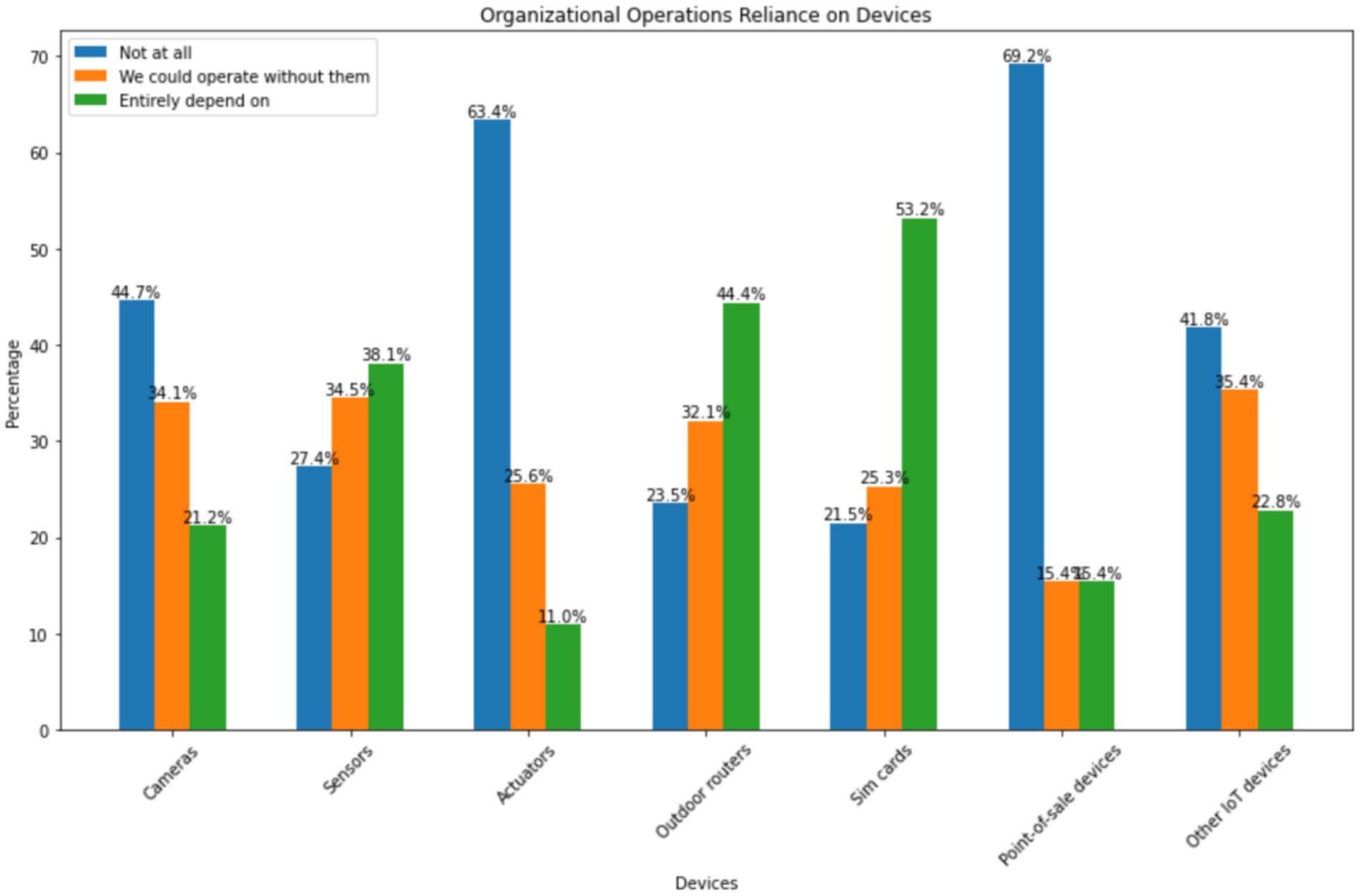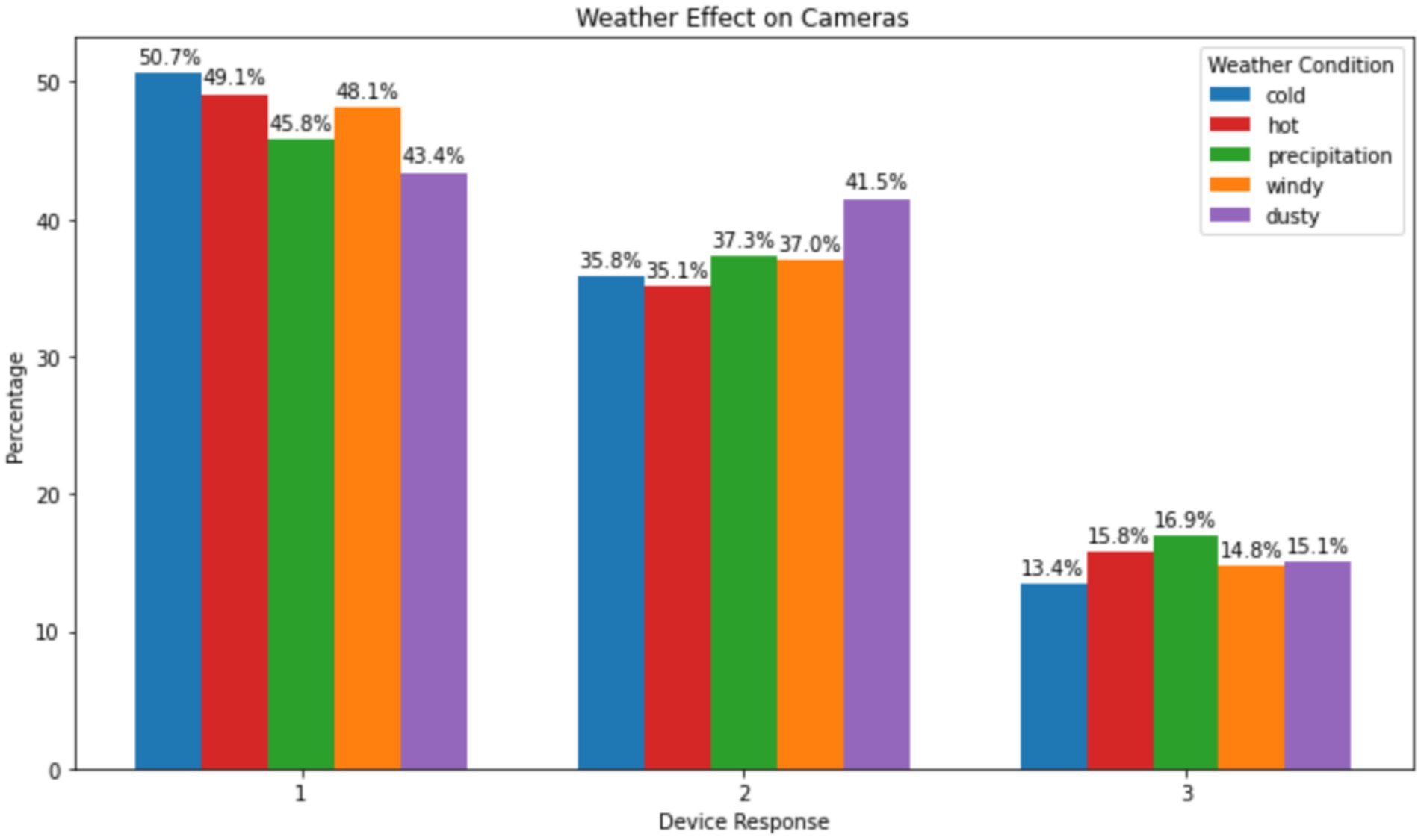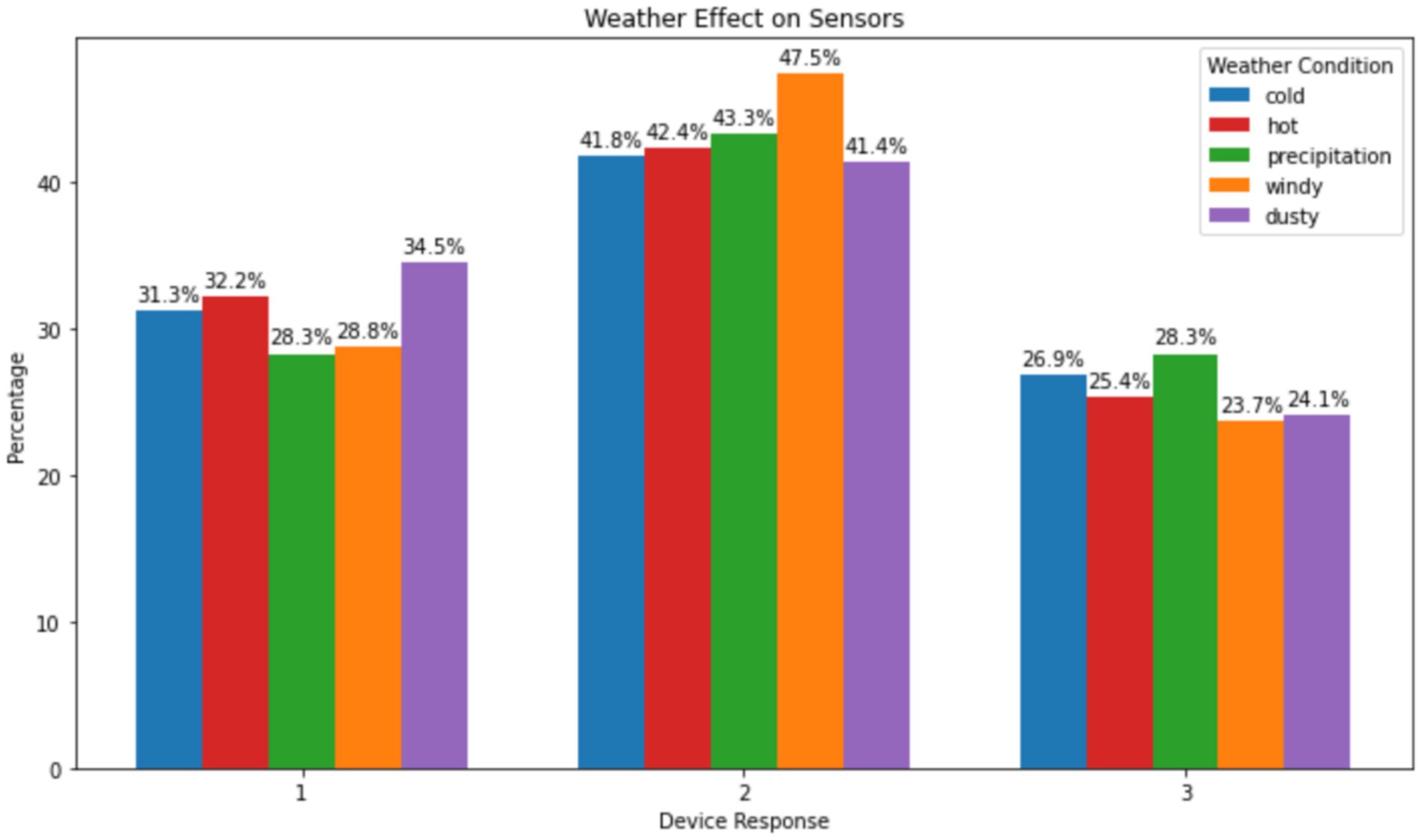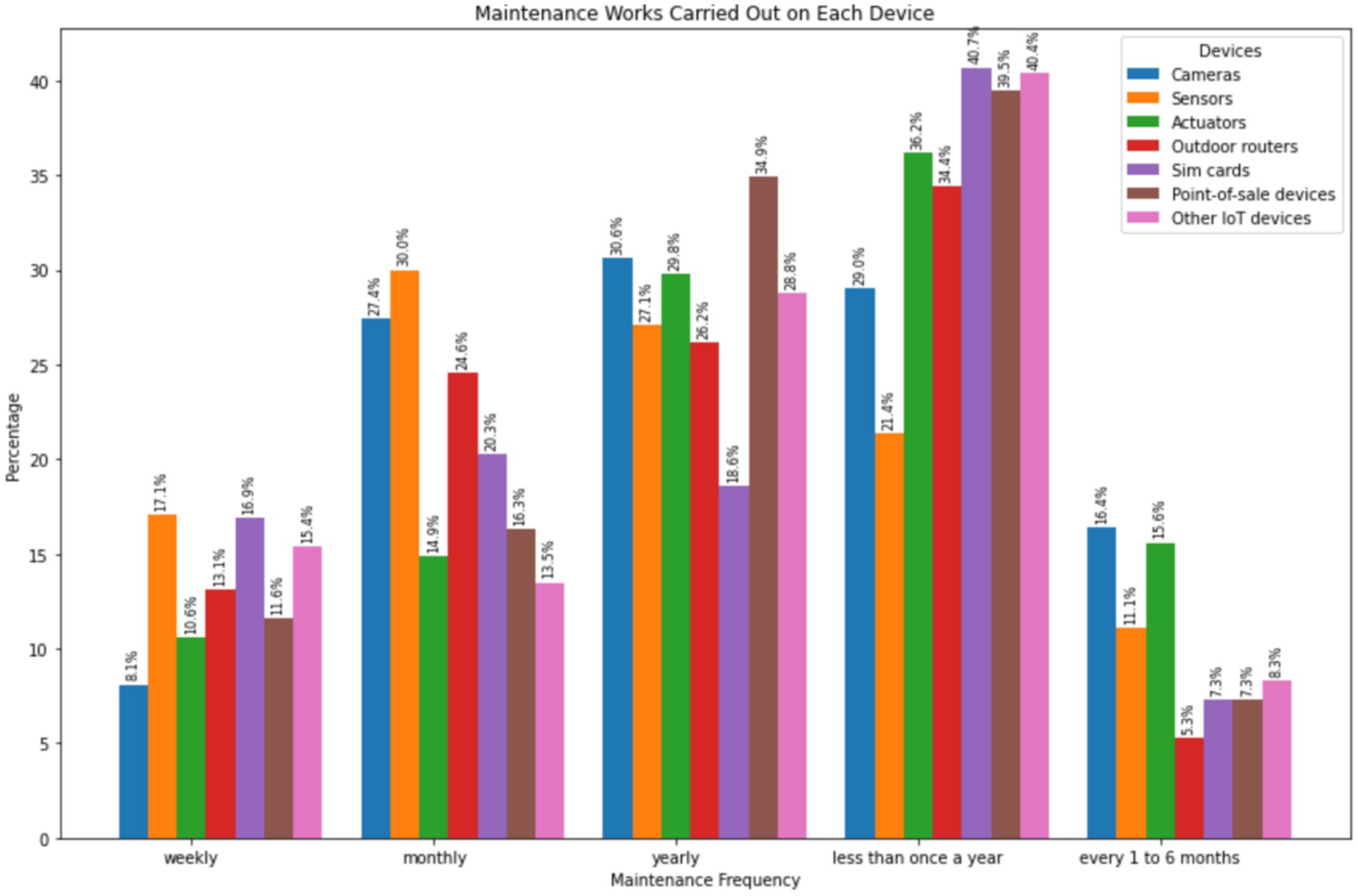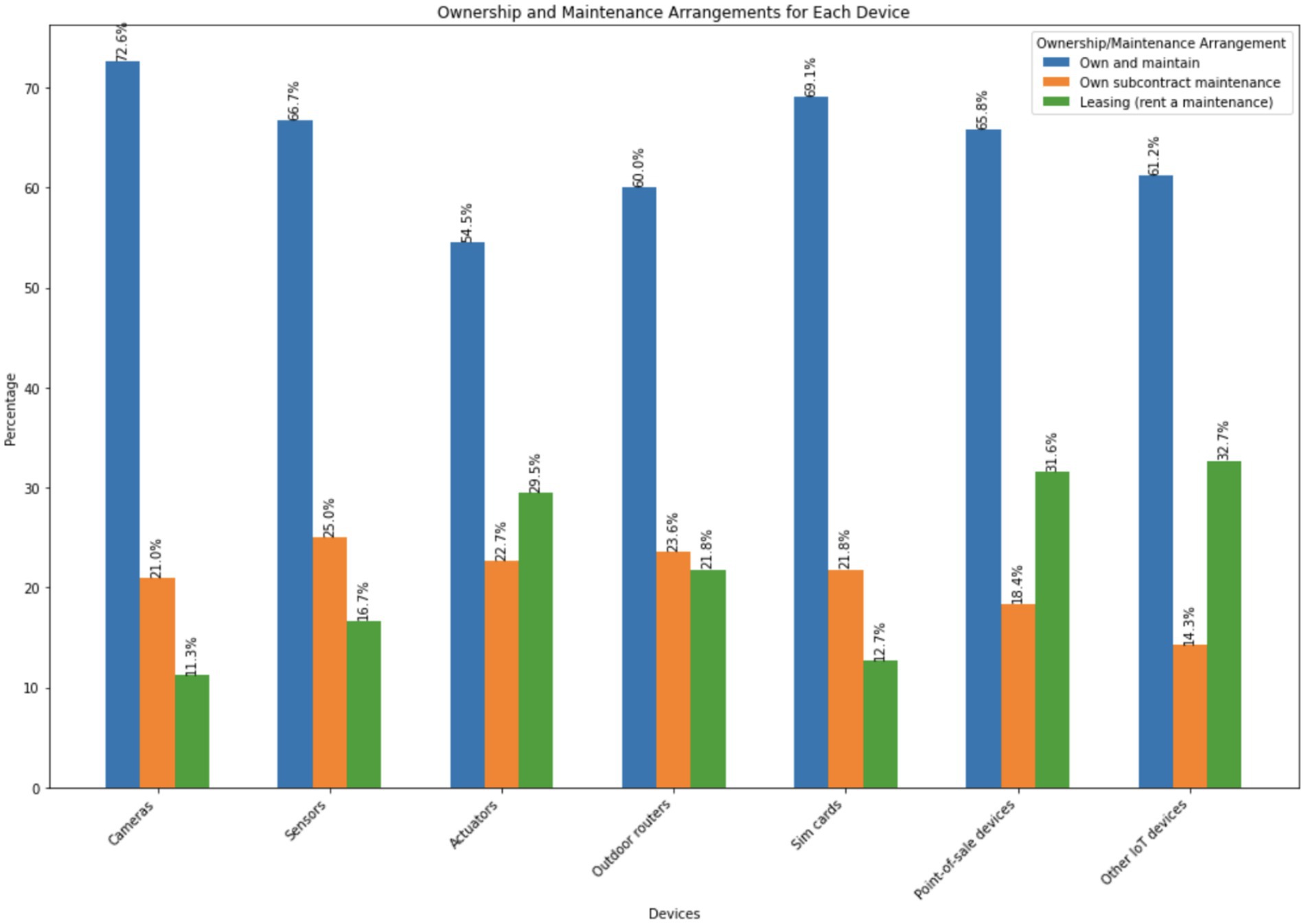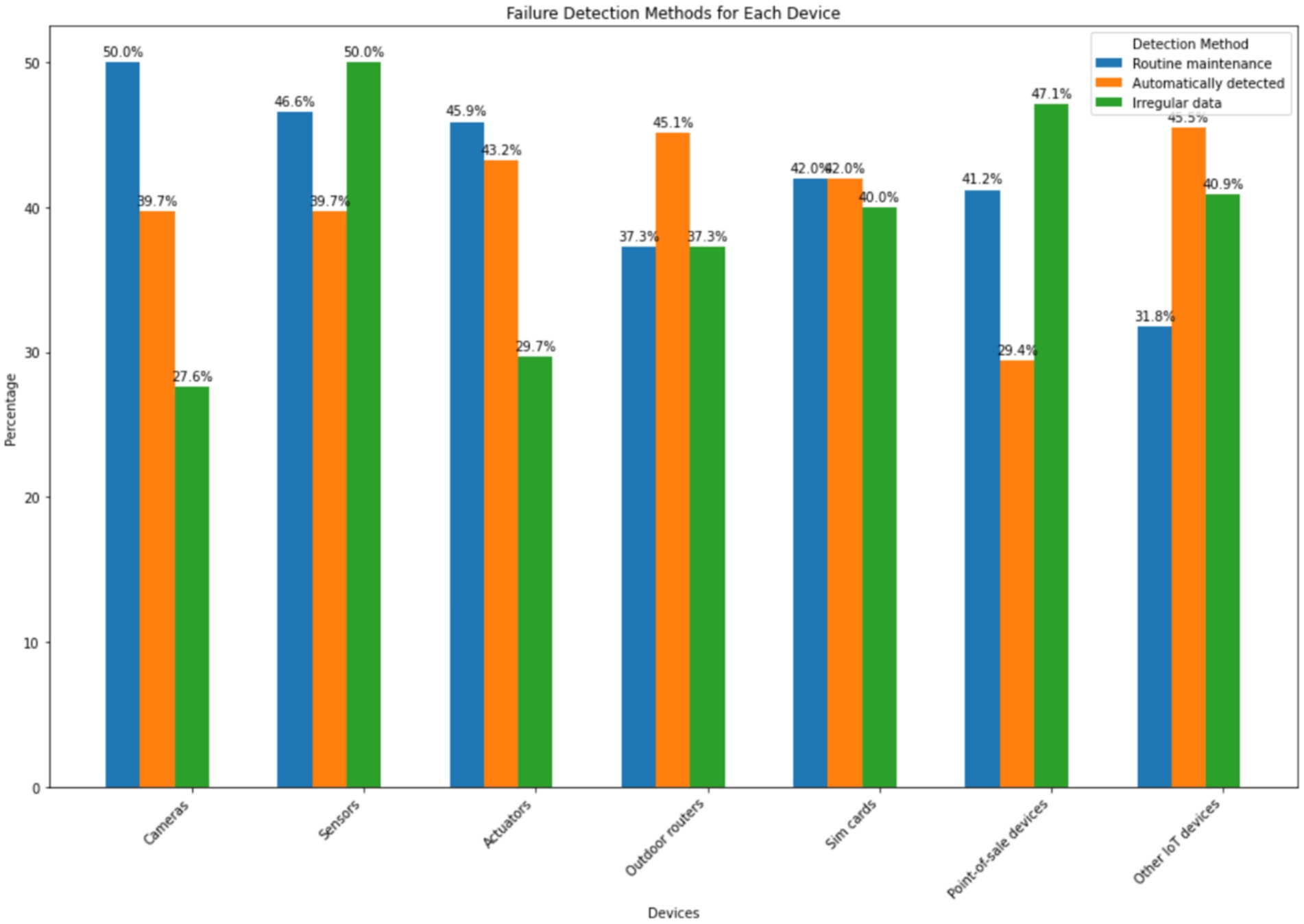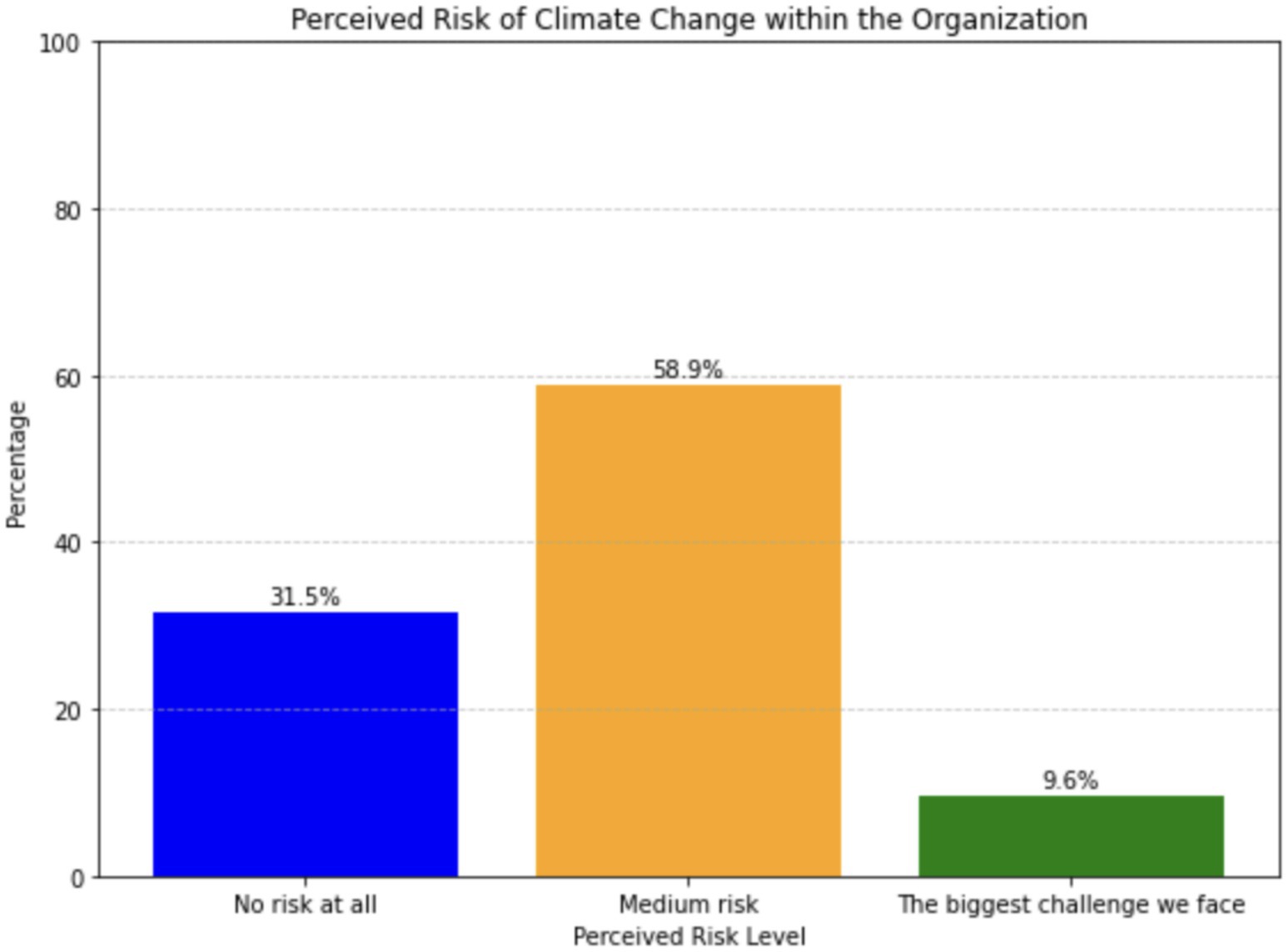- 1Department of Earth and Environmental Sciences, School of Natural Sciences, The University of Manchester, Manchester, United Kingdom
- 2Centre for Atmospheric Science, The University of Manchester, Manchester, United Kingdom
- 3School of Environment and Development, The University of Manchester, Manchester, United Kingdom
Climate change poses significant risks to the resilience of Internet of Things (IoT) infrastructure, especially in regions with extreme and variable climates such as Central Asia. Despite the rapid adoption of IoT technologies across sectors, limited attention has been given to how these devices perform under climate change. This study addresses this gap by analysing the results of an online survey of 150 stakeholders from public and private sector organisations in Kazakhstan, representing transportation, logistics, meteorology, ecology, and IT. The survey assessed organisational dependency on various IoT devices, perceived impacts of weather, maintenance practices, protective measures, and access to environmental performance data. The findings show that sensors, SIM cards, and outdoor routers are the most operationally critical, with sensors identified as the most climate-sensitive, requiring monthly or yearly maintenance and additional housing protection. In contrast, outdoor routers and actuators showed relatively higher resilience. Over half of respondents reported moderate climate change risk to operations, but a substantial information gap remains, with many organisations lacking vendor-provided performance data for extreme conditions. This lack of transparency limits informed procurement, risk assessment, and resilience planning. The study contributes one of the first regional assessments linking IoT operational risks to climate variability in Central Asia and provides actionable recommendations for integrating resilience into procurement standards, establishing open performance data repositories, and developing sector-specific adaptation strategies.
1 Introduction: a brief overview of the internet of things (IoT) and its importance for Central Asia
The Internet of Things (IoT) is a concept and paradigm that considers the ubiquitous presence of various physical objects (“things”) in the environment. The term “Internet of Things” is defined as a dynamic global network infrastructure with the ability to self-configure based on standard and compatible communication protocols, where physical and virtual “things” have identifiers and physical attributes, use intelligent interfaces, and are integrated into the information network (ITU, 2019). Despite the dominant use of IoT in the consumer sector, we see adoption in almost all industries (Alenizi and Al-Karawi, 2023). The Internet of Things increases the controllability of substations and power lines through remote monitoring in the electric power business, and it provides for a new degree of illness detection in healthcare—smart devices monitor patient health indicators (Rayan et al., 2021). Smart farms and greenhouses dispense fertiliser and water themselves in agriculture (Xu et al., 2022). The use of IoT in logistics reduces transportation costs while reducing the influence of the human component (Ivankova et al., 2020). The oil and gas and mining sectors are actively using IoT (Koroteev and Tekic, 2020).
IoT is also being used to address and monitor many environmental issues such as water pollution, waste management, deforestation, and air pollution (Murti et al., 2024). In theory, data collected from IoT networks can help reduce the negative environmental impact of human activities by collecting data on environmental factors, optimising resource usage, and reducing energy consumption (WBCSD, 2019). However, it is important to ensure that the development and implementation of these technologies are done in a responsible and sustainable manner. At present, there is a significant growth in IoT technologies, and it is estimated that, in the next decade, more than 125 billion IoT devices will be linked together based on current projections (Schiller et al., 2022).
The sensors that are used in the IoT are often deployed in remote and distant locations and can often be subject to harsh environmental conditions such as heat, freezing temperatures, mechanical wear, vibration, and moisture (Rayes and Salam, 2017). There is a need to determine the “useful life” period of a device so that we can determine when the device needs to be retired or adequately maintained. This useful life will shorten if the device is employed in a harsh environment. As a result, we could expect to see significant variability of device lifetime for identical devices deployed in different environments, which results in system reliability being difficult to manage (McClean and Yang, 2023). Unfortunately, such data are not made available by suppliers of IoT devices. While an operating range may be provided, this does not allow us to easily build appropriate risk models. In this study, we have taken the approach of conducting a user survey analysis to try and improve on the existing models.
The need for understanding the potential impacts of climate change on IoT networks is growing. We are already witnessing a huge investment in ‘smart cities’ built around the boom in IoT technologies. Central Asia is no different. According to Price Waterhouse Coopers (PWC), the development of the IoT was made possible by four technological trends: a decrease in the cost of computing capacity, a decrease in the cost of data transfer, a rapid increase in the number of “connected” devices, and the development of cloud technologies and Big Data systems (PWC, 2019). Research has similarly found that the expectations of companies from the implementation of IoT differ depending on the industry. In that same report, PWC notes that the introduction of Internet of Things technologies is quite complex and requires a clear strategy, implementation plan, and a comprehensive assessment of risks and benefits. We propose that such a strategy regarding climate resilience rarely exists, if at all. This, of course, has implications for whether the construction of IoT infrastructure aligns with long-term sustainable development goals.
Kazakhstan’s public and private sectors have invested in IoT infrastructure since 2017, aligning with “Industry 4.0” initiatives. In 2017, the Minister of Investments and Development announced that the Ministry would present a plan of transition of industrial enterprises to “Industry 4.0” technologies, which involves the introduction of such elements as autonomous equipment, the Internet of Things, and Big Data (Alam, 2018). According to the General Director of the “Phoenix Contact Kazakhstan,” a subsidiary of the German manufacturer of electrical equipment for industries, all industries are becoming more digital and mobile (Contact, 2019). While traditional industrial processes once involved siloed chains of supply and development, “Industry 4.0” technologies are quickly reconfiguring production workflows in the region (Phoenixcontact, 2021). In addition to that, there are IoT systems in households and public transport. Four cities of Kazakhstan, namely, Nur-Sultan, Almaty, Shymkent, and Aktobe, have run a pilot project called “Smart City.” With the construction of IoT infrastructure, we see important changes in regulations. Indeed, new laws have been developed that not only describe required standards between communication technologies but also introduce standardisation into a separate regulatory system (Kapital, 2017). All of this is designed to increase the export of domestic goods, provide a positive economic effect, help attract investment in the country’s economy, and provide a regulatory program for the development of smart cities.
There are several housing and communal service projects under beta testing. For example, in Nur-Sultan, applications are being introduced to enable residents of the capital to interact with communal service companies, simplifying processes and improving transparency of apartment owners (Zakon, 2014). We also see improvements in the data collection of consumed services. For example, the Kazakhstan company “Orion Systems” has developed their own accounting tools for the consumption of cold and hot water, gas, and electricity. Data are transmitted through networks based on the open Long Range Wide-Area Network (LoRaWAN) standard. Aside from improvements on the customer side, such devices have become essential among utility providers to find losses in the consumption of services and thereby increase the efficiency of their own activities. Of course, LoRaWAN standard technologies developed specifically for Machine-to-Machine (M2M) Interaction allow customers to connect many IoT devices that transmit a small amount of data per month, freeing them from the load of existing cellular networks. In Nur-Sultan, there are 200 radio modems for accounting hot and cold water, electricity, and gas. In Shymkent, there are 55 radio modems, and in Almaty, there are approximately 40 modems (Orionsystems, 2019). We can note that Nur-Sultan and Shymkent, in this regard, can be considered relatively advanced and not only for Kazakhstan.
Huawei launched a pilot project in Kazakhstan for the ongoing rollout of 5G. The main difference from previous generations (3G and 4G) is the huge (over 10 Gb/s) data transfer speed. In the context of using 5G IoT devices, speed is still not a determining factor. The first concern is the reliability of the network, the minimum signal delay, the ability to mass connect various smart devices with their specific tasks, and the continuity of their interaction. The national operator Kazakhtelecom has built a wireless network of the LPWAN standard using domestic equipment based on LoRaWAN technology. Such networks have low power consumption and wide territorial coverage. Based on this wireless network, various GPS trackers, motion sensors, smart traffic lights, and smart lighting can form an integrated urban network. There are limitations to the possibilities offered by cellular networks, as they use a licensed range and do not allow the full potential of the Internet of Things to be realized. Among the Commonwealth of Independent States (CIS) countries, Kazakhstan is leading in the implementation of M2M interaction solutions.
The concept and principles of IoT go far beyond the scope of projects described above. Notably, both globally and in Kazakhstan, projects are being developed in public transport, medicine, and education. For instance, Huawei has developed several ‘solutions’, such as Smart City, Safe City, Smart Education, and Smart Power Grids, implemented in more than 30 countries. For example, Safe City cameras provide high-quality, daytime and night-time videos for analysis (Huawei, 2023). In the capital of Tajikistan, Dushanbe, in 3 months of operation of the Safe City service, the number of road accidents decreased by 50%. In addition, service providers found more than 150 thousand traffic violations and more than 300 violations of public order (Kapital, 2017). Kyrgyzstan has implemented the Internet of Things too, where the main focus is on agriculture (Service, 2018), from monitoring the health and yield of crops through to the conditions of equipment. IoT integration in housing services provides the potential to build autonomous systems. These technologies could help to use resources more effectively and provide warnings to management systems about the location of problems related to water and gas supplies, which is very important in Kyrgyzstan. The most dynamic development of IoT technologies has taken place in household implementation under the “Smart home” concept. Sensors and device controls allow for reducing utility expenses, preventing accidents, equipment breakage in the house, and improving comfort and security (Dobre et al., 2016).
To summarise, IoT is driving developments and investment across multiple sectors in the region. While data on the climate resilience of key technologies are lacking, the purpose of this study is to highlight the risks and performance of IoT devices in different weather conditions in the context of better understanding user perception around climate resilience and risks. The findings of this research are based on an analysis of a survey in which 141 individuals from public and private sector organisations provided their opinions and working experiences. For this, we created surveys using the University of Manchester Qualtrics survey platform (UoM, 2023). This was done jointly with partners in Kazakhstan. As we will present in the following sections, the survey allowed us to understand different aspects of IoT resilience that stakeholders are conscious of, potential impacts, broad types of potential failures, and the associated perceived risks.
The rest of this study consists of the following sections: Section 2 provides a brief literature review on the broad IoT technologies in operation, based on the sectors in which it is used across the region. We also attempt to summarise broader mitigation strategies in this area and the known patterns of climate change across Kazakhstan. Section 3 presents the methodology used in constructing and deploying the user survey, followed by an analysis of that survey in Section 4. Finally, Section 5 summarises the results of the stakeholder survey with recommendations for future research.
2 IoT technologies investigated
The survey used in this study focused on a range of IoT devices, particularly cameras, sensors, actuators, outdoor routers, SIM cards, POS devices, and ‘other’ IoT devices. This was designed to cover key aspects of an IoT network, from monitoring and sensing technologies to data communications, transactional exchange, and mechanical components. A broad use case of a connected IoT network, especially in a country with a large geography, extreme climate conditions, and changing logistical needs, is one designed to improve logistics and transportation resilience (Figure 1). Indeed, Kazakhstan, as one of the centres for regional and international trade, is dependent on strong logistics and transportation connections to effectively manage the transportation of goods, resources, and people (Kredina et al., 2022). Expected technologies and applications for each component are given below, including examples that would fall under ‘other’ IoT devices:
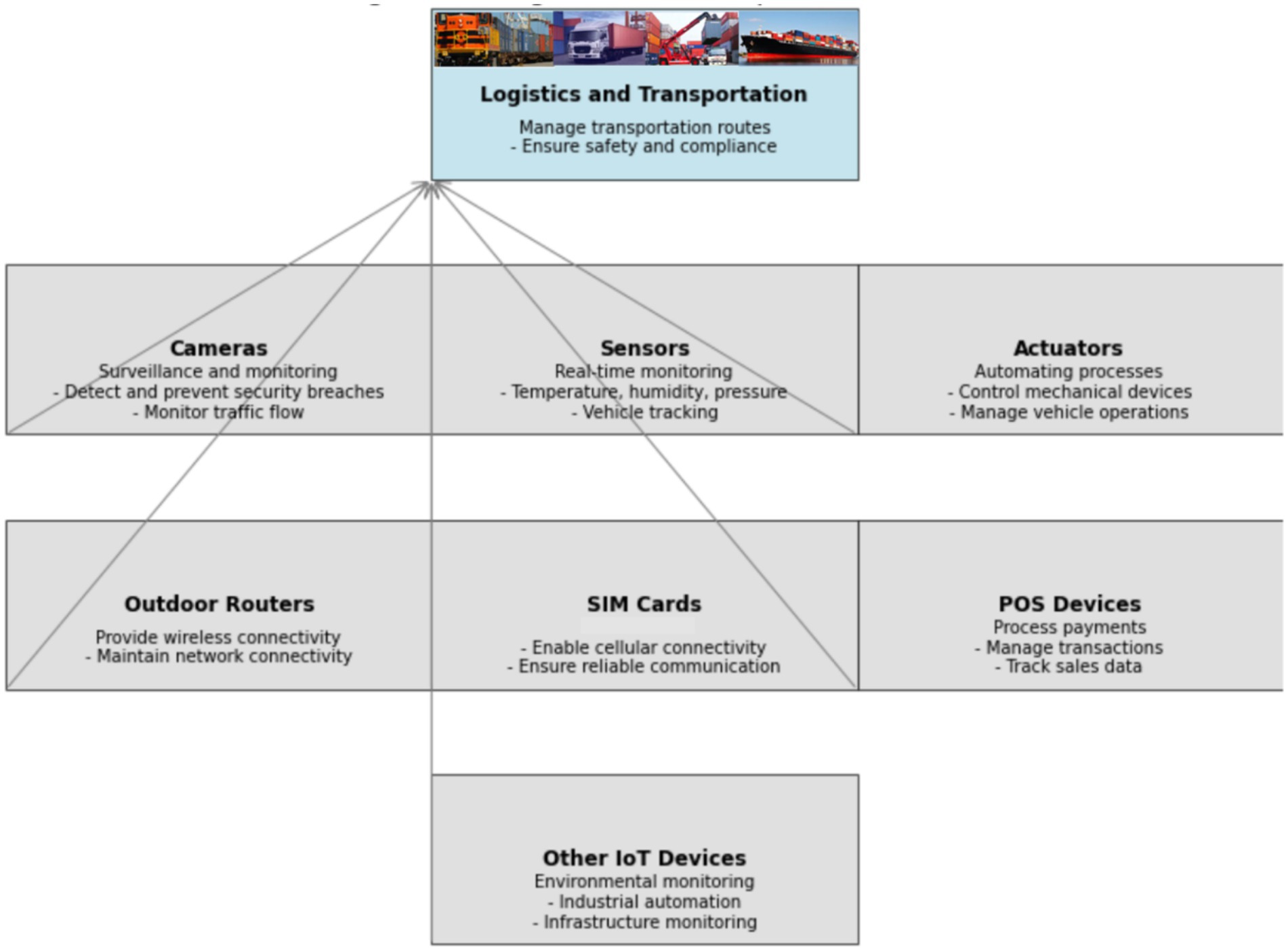
Figure 1. Interconnected IoT technologies supporting improved logistics and transportation, with examples of either technologies or applications given under each category.
Cameras: Surveillance and monitoring systems need cameras to identify and prevent security breaches, monitor traffic movement, and ensure safety compliance. A country with transportation networks and key infrastructure needs effective monitoring systems to protect these assets.
Sensors: Sensors monitor temperature, humidity, pressure, and vehicle tracking in real time. They provide essential information regarding climatic conditions, vehicle performance, and shipment status, enabling efficient logistics operations and timely decision-making processes.
Actuators: Kazakhstan’s particular temperature and geography require strong sensors to optimise transportation routes, manage cargo conditions, and ensure vehicle safety. Automation in logistics and transportation systems relies on actuators. They enhance the management, vehicle movement, and autonomous vehicle control by manipulating mechanical systems. Kazakhstan’s transportation system requires reliable actuators that improve shipment management, vehicle performance, and logistical efficiency.
Outdoor Routers: Wireless connectivity through outdoor routers allows communication between IoT devices, vehicles, and central monitoring stations, even in remote or hard-to-reach locations. Robust outside routers are needed to sustain stable Internet connections and enable real-time monitoring of transportation networks.
SIM Cards: SIM cards enable IoT devices’ cellular access, ensuring reliable communication in low-coverage locations. They ensure uninterrupted data sharing between IoT devices and centralised monitoring systems.
Point-of-Sale Devices: Retail, commercial, and logistics and transportation operations depend on point-of-sale (POS) devices. In Kazakhstan’s developing retail and logistics industry, they streamline transactions, inventory management, and logistics operations to improve supply chain management and customer service.
Other IoT Devices: We use this category to cover any IoT components that do not fall into the aforementioned categories. These may also be used for the monitoring aspects of logistics, transportation, industrial automation equipment, and infrastructure monitoring devices designed to improve logistics and transportation efficiency, safety, and sustainability.
2.1 Climate resilience
It is widely understood that climate change will have unavoidable consequences for urban systems, transport, and population health. This is particularly true in Central Asia, where many large cities are already experiencing significant changes in weather patterns (IPCC, 2022). Effective climate adaptation will be required, and adaptation planning can be simplified by operationalising concepts of climate resilience and vulnerability (Zaidan and Bahaa, 2020). There are several technological features of an IoT network that are subject to risk (Figure 2) (Delic, 2015). For example, based on the network components highlighted in this report, we have listed below several environmental stressors:
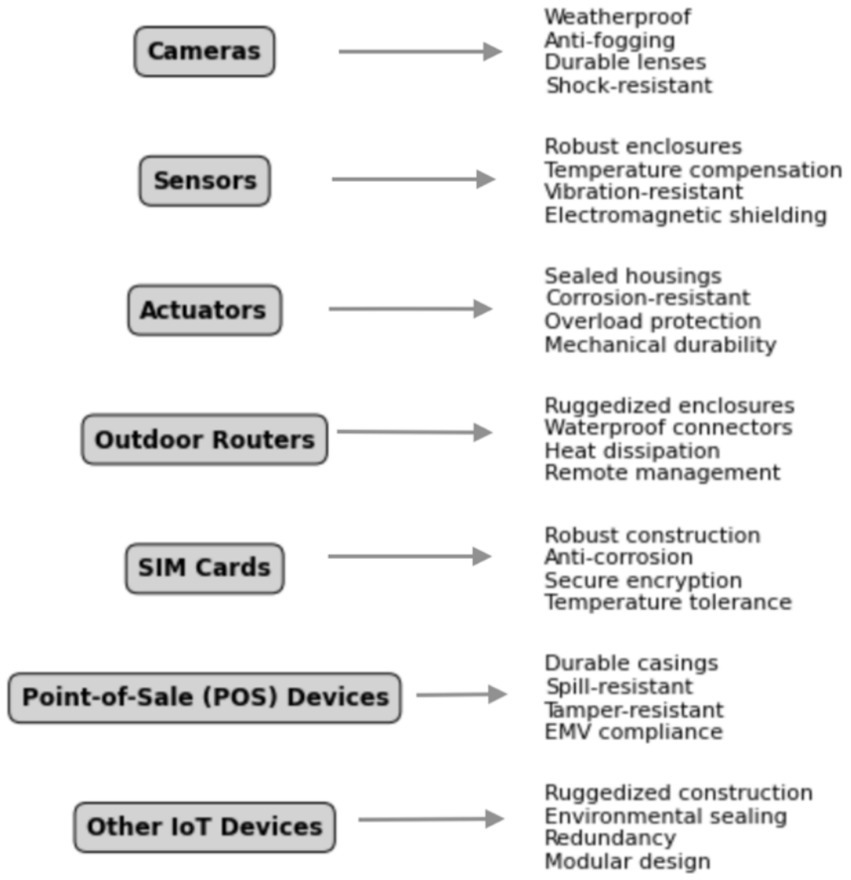
Figure 2. Examples of technological interventions designed to improve the resilience of IoT devices (Delic, 2015).
Cameras: Potential risks include direct physical damage to the cameras, which can lead to the loss of data. Increased humidity or extreme temperatures could lead to condensation inside the device, resulting in the loss of quality and device failure (Delic, 2015). Extreme temperatures could similarly lead to the damage of central components.
Sensors: Risks include decreases in data accuracy due to electrolyte evaporation or dilution, entrapment of contaminants, and repeated exposure to wide swings in T or RH (Sehrawat and Gill, 2019; Cross et al., 2017).
Actuators: Extreme temperature and high humidity may damage actuators and degrade their performance. Another potential risk is condensation, which may cause damage to the components of actuators (Elgazzar et al., 2022).
Outdoor Routers: Different weather conditions, such as rain, snow, dust, storms, and wind, can cause damage to the housing of routers. Extreme temperatures have the potential to cause the router to overheat or overcool, which will eventually result in its failure.
SIM Cards: High humidity can damage the SIM card contacts and cause loss of communication. Extremely high temperatures may lead to plastic deformation of the SIM card and its damage.
Point-of-Sale Devices: Heatwaves and cold temperatures can cause failure and loss of data. It is also possible that the card reader and the keyboard will experience problems if the humidity is too high (Saad et al., 2022).
Other IoT Devices: Common potential risks include damage to the housing and central components of the device when exposed to extreme and varying climate conditions.
Factoring all of these risks in a strategic way is difficult. In the face of limited or no data on empirical climate resilience, this research examines what organisations are doing in practice to manage and prevent risk in extreme and evolving weather conditions. It is hoped that this evidence can be used to eventually build a framework that brings together theoretical and empirical knowledge of the factors that contribute to resilience, as well as processes for putting those ideas into action. The framework should then include urban system characteristics, agents (people and organisations) who rely on and manage those systems, institutions that connect systems and agents, and patterns of climate change by region.
Central Asia, the Asian continent’s core region, consists of Kazakhstan, Kyrgyzstan, Turkmenistan, Uzbekistan, and Tajikistan. This region’s landscape is characterised by grasslands and desert, with a transition from steppes to semi-desert in the south. Most areas experience less precipitation, more evaporation, and large diurnal and annual temperature fluctuations, particularly in Kazakhstan and Turkmenistan. Kyrgyzstan and Tajikistan are located in mountainous regions, with lower annual mean temperatures but higher precipitation. Summer temperatures typically range from 2 to 31 °C, while winter temperatures typically range from 25 to 7 °C. More precipitation falls during the winter and early spring. During periods of extreme heat or cold, it becomes hard to manage outdoor facilities and devices used in transport operations (Worlddata, 2022).
Climate is critical for determining the development of many sectors of the economy as well as the health of any state’s population. Meteorological information collected, managed, and analysed by national hydrometeorological services helps users, including several decision makers, plan any activity while taking current climatic conditions and observed climate changes into account. The use of up-to-date meteorological and climate information aids in the reduction of risks and damages as well as the optimisation of socioeconomic benefits. National, regional, and international organisations monitor the climate system under the coordination of the World Meteorological Organization and in collaboration with other environmental programmes. According to the meteorological office of Kazakhstan, the average annual air temperature in Kazakhstan has been steadily rising across the country. Every 10 years, the average annual air temperature increases by 0.32 °C across Kazakhstan. The average growth rate for the territory of individual regions ranges from 0.22 °C/10 years (Karaganda region) to 0.52 °C/10 years (West Kazakhstan region). The increase in temperature is statistically significant in all seasons except winter (Kazhydromet, 2023). To enhance devices’ resilience to climate risks, businesses can utilise well-established methodologies and approaches in risk management. These involve three crucial stages: identifying potential business and strategic risks, gaining comprehensive knowledge of the risks involved, and devising a mitigation strategy. Such an approach implies a significant shift in businesses’ management of resilience and adaptation to climate change, as climate risks should be regarded as major business risks and their mitigation should be integral to business strategy. Since climate change impacts continually evolve and pose new threats, regular risk assessments are also going to be essential. Implementing these measures can result in investments in innovative technologies and expansion into new areas of the industry (WBCSD, 2019).
2.2 Climate change in Kazakhstan
Kazakhstan is located in the midst of the Eurasian continent, approximately 2,000–3,000 km, from the nearest ocean. Evidence shows that the region is warming faster than the northern hemisphere and the world as a whole (Oladejo et al., 2023). There is a distinction between the list of the world’s warmest years and the list of Kazakhstan’s warmest years. The 5 warmest years in Kazakhstan correlate with the 10 warmest years globally: In 2015, Kazakhstan ranked third in the world in terms of yearly average temperature anomalies, whereas the United States ranked first. The yearly average temperature anomaly in 2015 was 5.7 °C above the long-term average. The West Kazakhstan region saw the fastest increase in average annual temperature, equivalent to 0.38 °C every 10 years, while the South Kazakhstan region experienced the slowest increase (0.22 °C per 10 years). In all locations, the last 30 years have been characterised by years with significant positive anomalies in average annual temperature (Kazhydromet, 2023). Except for Atyrau and the West Kazakhstan area, where it was 0.38 and 0.46 °C, the rise in winter temperatures was within 0.18–0.31 °C/10 years. Every 10 years, the temperature in the southern and eastern parts increased by 0.21–0.28 °C, in the western and south-western areas by 0.32–0.42 °C, and in the central and northern areas by 0.35–0.38 °C. In general, 2021 ranks among the top 5 or 7 warmest years globally since the beginning of recorded observations (ECMWF, 2021). In 2021, the worldwide average annual temperature was approximately 1.11 ± 0.13 °C higher than the baseline 1,850–1,900 level, which is used as an estimate of pre-industrial temperatures. According to statistics from the Kazakhstan meteorological office, the average annual air temperature in Kazakhstan in 2021 was 1.58 °C higher than the climatic standard for the period 1961–1990. It was the sixth-highest value in the ranking of the hottest years since 1941. In 2021, Turkestan, Mangystau, West Kazakhstan, Aktobe, and Kyzylorda were among the top 5% regions with exceptionally warm years, with anomalies ranging from + 1.89 °C to + 2.28 °C. For the Atyrau region, 2021 was a record warm year, with an average temperature anomaly of +2.63 °C (Kazhydromet, 2021). The majority of meteorological stations in the country’s western, southwestern, and southern areas recorded extremely high yearly temperatures. Furthermore, 2021 was the warmest since 1941, according to 19 meteorological stations in the western and southern areas, with record temperature anomalies ranging from +1.4 to +3.2 °C (Figure 3) (Kazhydromet, 2022). The months of May through August were exceptionally hot in several parts of Kazakhstan. Except for the highlands, the maximum temperature in 2021 has surpassed 30 °C and even 35 °C across Kazakhstan.
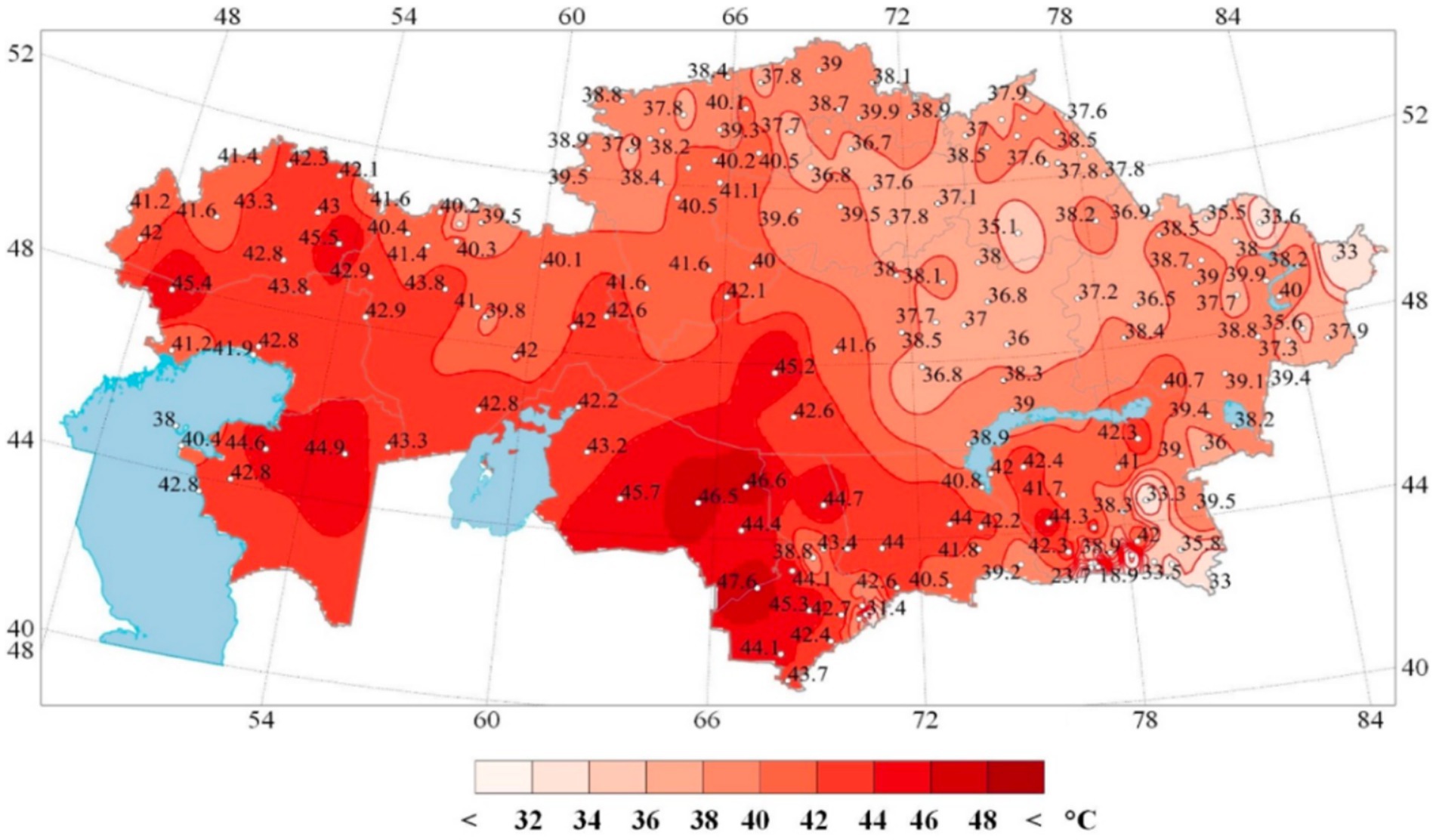
Figure 3. Values of the maximum daily air temperature recorded in 2021 (Kazhydromet, 2022).
Absolute maximums were updated in 2021 at eight weather stations involved in monitoring Kazakhstan’s climate. The overall duration of all heat waves in the western and southern areas exceeded 50 days, and in some locations, they exceeded 60 days. As a result of high air temperatures over a substantial portion of the summer season, particularly in Kazakhstan’s western and southern areas, there was an urgent need to cool the buildings to maintain a comfortable temperature. The average precipitation layer for the year 2021 in Kazakhstan was 271.5 mm (86% of the norm). Annual precipitation quantities were approximately 20% of the norm across most areas. Precipitation deficits (up to 30–40%) were noted in the republic’s western, southern, and central areas. The Mangystau area experienced a significant precipitation shortfall (up to 70%). For the majority of the year, Kazakhstan’s average rainfall was below normal. Two months were exceptionally dry: May, with precipitation at approximately 45% of normal, and April, with 58% of normal. A considerable precipitation deficit was also noted in January (23%), as well as from June to December (13–34%). February (185.8% of the norm) and March (191.6% of the norm) were both unusually rainy months. From April through October, the majority of Kazakhstan’s area had a precipitation deficit. Monthly precipitation minimums have been updated at certain locations, while monthly maximums have been updated at others. Many stations in the western, central, and southern areas reported no precipitation for at least a month. Kazakhstan’s climate is changing. All areas of Kazakhstan are seeing a continuous increase in average annual air temperature; on average, the increase in average annual air temperature in Kazakhstan is 0.32 °C per 10 years. The average growth rate for the territory of individual regions ranges from 0.23 °C/10 years (Karaganda region) to 0.54 °C/10 years (West Kazakhstan region). The temperature increase is statistically significant in all seasons except winter. All trends in Kazakhstan’s average annual and seasonal precipitation are statistically negligible. There is a slight tendency towards a rise in annual precipitation (by 1.1 mm/10 years), primarily owing to spring precipitation, with increases of 10–20% per 10 years in some western and northern locations. During the fall season, the amount of precipitation decreases across Kazakhstan, decreasing by 4–13% per 10 years in some western and southern districts. Analysis of trends in surface air temperature extremes and precipitation for the period 1961 to 2021 showed the following: (1) there is a steady increase in the number of summer days with temperatures above 25 °C and 30 °C, as well as tropical nights with temperatures above 20 °C, especially noticeable in the south, south-west, and west of the republic; (2) there is an increase in the number of heat waves in the warm season, the total and maximum duration of heat waves, and the duration of heat waves in the whole year increases across the country; (3) there is a reduction in heat deficit (the need for heating) in the cold period of the year and an increase in the shortage of cold in the warm period (the need for air conditioning), especially in the south-west and west of the republic; (4) there is a steady increase in the period of active vegetation with an average daily temperature above 10 °C, as well as the sum of active temperatures for this period, across the country; (5) the number of days with frosts and with severe frosts below minus 20 °C is reduced; and (6) there have been no significant changes in the characteristics of the extremity of the precipitation regime in most of the territory of the republic. The observed increase in the frequency and duration of periods with high air temperatures during the warm season has negative consequences not only for the human body and animals but also for the transportation infrastructure due to road surface deformation, for the conditions of the urban environment and recreation areas, and for the energy industry, as there is a need for additional energy production to cool the premises. As the surface temperature rises, freezing conditions become less frequent, with precipitation typically falling in liquid form. This, in turn, can have an impact on snow accumulation throughout the cold season. In mountainous places, both the extent and duration of solid precipitation are diminishing, affecting glacial systems (Kazhydromet, 2021). An increase in surface temperature during the cold season reduces the requirement for thermal energy generation. On the one hand, reducing the number of frosty days benefits public health; on the other hand, heat waves during the winter season can contribute to the creation of black ice on roadways when the cold returns. Increasing the length of the growing season, when accompanied by an increase in rainfall and a reduction in the maximum duration of the rainless period (in some northern and southern locations), enhances agricultural production conditions. Increased maximum daily rainfall in some locations may raise the danger of damage to roads and drainage systems in settlements, as well as landslides and mudflows in mountainous areas (Kazhydromet, 2021).
3 Survey methodology
According to Anand (2024), descriptive research is devoted to the gathering of information about the current conditions or situations for the purpose of description and interpretation; this type of research method includes proper analyses, interpretation, comparisons, and identification of trends and relationships, along with amassing and tabulating facts. In this section, we describe the survey method used in our study. We provide an overview of the type of questions asked, our selection of respondents, and the rationale for making these choices. Methodology is a systematic approach to solving the research problem (Anand, 2024). It may be regarded of as a science that studies how scientific research is conducted (Anand, 2024). In it, we look at the many processes that we take when examining a research issue, as well as the reasoning behind them. We must understand not only the research methods/techniques but also the methodology; on the other hand, we should not only understand how to create specific indices or tests, calculate the mean, mode, median, standard deviation, or chi-square, and apply specific research techniques. We should also understand which of these methods or techniques are relevant and which are not, and what they mean and indicate and why, as well as comprehend the assumptions underpinning diverse methodologies, the criteria by which we may determine whether some techniques and processes are appropriate to certain issues and others are not (Thomas and Harden, 2008). By selecting a case study approach that focuses on a single country, an in-depth analysis can be conducted on the way in which IoT devices overcome climate-related challenges within the specific context. Reaching a wide range of respondents was practical and efficient by using an online survey. Statistical and qualitative methodologies were used to analyse the data, which were securely stored depending on the kind of data collected.
Selection of Respondents: We used a quota sampling approach to select participants for our survey. The population of this research included private and public organisations in Kazakhstan, specifically in the fields of transportation, logistics, climate, meteorology, ecology, and IT. We then selected participants from each organisation, stratified by job title and level of involvement in IoT-related projects.
Question Development: The survey questions were informed by the literature on the climate resilience of IoT devices. We focused on gathering information about the respondents’ experiences with IoT devices and their climate resilience, the challenges they faced, and the benefits they perceived. We also asked about their perceptions of the potential for future development and deployment of these devices. An online-based survey was created using the University of Manchester Qualtrics survey platform. To ensure that the questions were understandable, readable, and appropriate in the context of the study, a draft of the survey was reviewed by five members from the related fields. Following the creation of the survey, a pilot study was conducted at the University with a researcher and her supervisors. The feedback received from the pilot study was used to modify the final survey with versions available in both English and Russian. To ensure confidentiality, all respondents were required to sign consent forms that outlined the purpose of the study and provided contact information in case of any questions. A total of 150 respondents were targeted for this study, with the requirement that they must be one of the employees in the related organisation. The survey was distributed on the Kazakhstan E-Otinish website, which is a government request website for citizens.
Type of Questions: The survey questions were a mix of closed-ended and open-ended questions. Some of the closed-ended questions included the following: How reliant are your organisation’s operations on each type of device? How does the weather affect each type of device listed in the left-hand column, using the broad conditions outlined in each column heading? How often are maintenance works carried out on the devices? The open-ended questions were designed to elicit detailed responses from respondents. Some of the questions we asked included the following: “If you would like to see the summary of the results, please leave your email address in a box below. If you are interested in discussing these issues further and how our research could help your organisation, please leave your email address in the box below.” We will be delighted to arrange a follow-up interview.
In conclusion, we have described our selection of respondents, the development of survey questions, and the type of questions we asked. We believe that the insights gained from these surveys will provide valuable information for future research and the mass deployment of IoT devices in climate resilience. All survey responses were analysed using analysis software. Both exploratory and confirmatory analyses were used to validate the instrument. Further details on these instruments and their application in the study are provided in the following sections.
4 Results and analysis
In this section, we present the survey responses regarding the role of IoT in public and private sectors, along with associated risks and dependencies. Due to the complexity of the topic and the diversity of professions, the results are summarised and presented mainly in the form of summaries and quotes. The sources of the quotes were not provided to protect the anonymity of the participants. The quotes were used to illustrate various points of view, rather than official opinions of the organisation. In this section, we will evaluate each question, providing an analysis of its content and implications. We follow the same numbering scheme used in the survey, starting at number 3.
4.1 Question 3
How reliant are your organisation’s operations on each type of device?
We found that the level of organisational reliance on different types of IoT devices varies, as summarised in Figure 4. Overall, the results show that most organisations depend on sensors (38.1%), SIM cards (53.2%), and outdoor routers (44.4%) for operational purposes. In contrast, a lower number of organisations depend on actuators (11%), point of sale devices, and cameras (21.2%). This may reflect the balance of sector representation in survey participants.
4.2 Question 4
In question 4, we review participant experiences around weather effects on each specific device, where users were asked to record device response to specific weather conditions: (1) not at all, (2) medium, and (3) highly affected. To summarise, most devices appear to work consistently across diverse weather conditions, with no obvious bias towards any specific weather conditions. In our survey, more participants reported that most devices are not affected by specific weather patterns, compared to those who indicated medium to high dependencies. This trend is illustrated in Figure 5, where we find evidence of some dependency on camera operations on specific weather conditions, with modest differences in performance across cold, heat, precipitation, windy, and dusty environments (Figure 5).
This is in contrast to results from user experience in sensors. From question 4, we found a marked change in trend between no dependency on weather conditions to users judging there to be a medium dependency (Figure 6). Similar to cameras and other devices, sensors also function well across a variety of weather conditions, with only minor differences in utilisation percentages between cold, hot, rainy, windy, and dusty conditions.
Figures 5, 6 in the appendix present and confirm the trend for remaining devices, as summarised above.
4.3 Question 5
From question 5, we found interesting changes in the frequency of maintenance work, depending on the device. The majority of camera maintenance is done yearly (30.6% of participants) or less than once a year (29.0%). On the other hand, the most common maintenance frequency for sensors is monthly (30.0%), followed by yearly (27.1%). This finding aligns well with results from the previous question, where users find that sensors have a higher propensity to experience some impacts of variable weather conditions. Actuator maintenance is conducted less often, with the most typical maintenance frequencies being less than once a year (36.2%), which is the same for outdoor routers (34.4%). The outdoor router maintenance is performed monthly (24.6%) and yearly (26.2%). Maintenance is performed less than once a year (34.4%). Similarly, the bulk of SIM card maintenance is done less than once a year (40.7%), which is also found for point-of-sale devices (39.5%) and other IoT devices (28.8%). Overall, the data reveal that the majority of devices in Kazakhstani organisations require maintenance at least once a year, with yearly and less than once a year schedules being the most typical maintenance frequency for various device categories. Maintenance frequencies of weekly and every 1 to 6 months are less common across all device kinds. This information is represented in Figure 7.
4.4 Question 6
Regarding ownership and maintenance arrangements, the results (Figure 8) show that organisations in Kazakhstan prefer to own and manage their IoT devices, perhaps allowing them greater control and customisation. A subset of organisations also choose subcontracting maintenance and leasing, indicating a balance between in-house competencies and external help. There is a change between the ratio of participants who state that their organisations own devices and subcontract maintenance compared to those who lease a device, when we look at the use of actuators, point of sale, and other IoT devices, in contrast with all other categories.
We may assume that subcontracting maintenance is chosen by a smaller percentage of organisations, when compared with direct ownership and maintenance, presumably owing to resource restrictions or competence needs within specific organisations. Where there are leasing arrangements, this could be preferred for flexibility and cost-effectiveness.
4.5 Question 7
Data on device protection measures in organisations provide valuable insights into the risk management strategies used by participants. Overall, the results indicate that warranties are the most popular type of protection in Kazakhstani organisations. This emphasises the need to obtain warranty coverage to limit potential hazards and maintain smooth device functioning. Furthermore, a substantial proportion of organisations choose additional physical protection, such as housing, showing a proactive commitment to device protection. We found that sensors and other IoT devices have the highest frequency of additional protection in this regard. Insurance is selected to a lesser extent, but it nevertheless provides additional protection against unanticipated catastrophes or damages.
4.6 Question 8
Regarding understanding which methods participants use to detect failure, we found that routine maintenance is the most prevalent strategy (Figure 9). This finding aligns with the higher maintenance frequency reported for sensors in Question 5, which provides insights into how often maintenance is applied. Automated detection methods appear to dominate the use of outdoor routers and other IoT devices, likely reflecting the embedded technology within such devices. Monitoring irregular data patterns is another common strategy that organisations utilise, with a marked increase in the use for deployment of sensors and point-of-sale devices.
4.7 Question 9
In this question, we attempt to understand user perceptions of the risk of climate change.
The results from the organisation’s perception of climate change risk reflect a diverse range of viewpoints. While a significant portion, accounting for 31.5%, perceives no risk at all, the majority, comprising 58.9%, acknowledges a medium level of risk. Interestingly, a smaller yet notable 9.6% of organisation identify climate change as the most significant challenge faced by the organisation. Building upon these perceptions, it is essential to delve into the vulnerability of various IoT devices concerning climate change. The assessment categorises these devices into three risk levels: no risk at all, medium risk, and the biggest challenge they face, as shown in Figure 10. Among these, sensors emerge as particularly vulnerable, with climate change expected to significantly impact their performance. In addition, other IoT devices such as SIM cards, POS terminals, and cameras pose a moderate risk, warranting attention to mitigate potential climate-related issues. Conversely, outdoor routers and actuators demonstrate greater resilience to changing weather patterns due to their lower vulnerability. This assessment underscores the necessity of implementing policies to address the ramifications of climate change, especially for highly vulnerable devices such as sensors. By visualising the distribution of risk levels across different IoT devices, the importance of proactive management strategies becomes evident. Overall, the assessment emphasises the need to strengthen the resilience of susceptible devices while capitalising on the robustness of less vulnerable technologies within organisational frameworks.
4.8 Question 10
From question 10, we attempt to understand the availability of information provided, or openly accessible, on the performance of IoT devices under different weather conditions. This finding could include operating ranges provided by IoT vendors and/or evidence in the scientific literature. Overall, the results indicate that a significant portion of respondents face challenges in obtaining comprehensive information on IoT device performance in different weather conditions. While this may reflect and confirm (user perceived) resilience in some cases (e.g., actuators), it does not reflect the perceived risk and require maintenance, e.g., sensors. Of course, further understanding dependencies on a specific type of sensors and underlying technologies forms an important next step.
Data availability and accessibility improvements may improve decision-making and maintenance strategies for IoT devices in Kazakhstan organisations.
4.9 Question 11
Question 11 was excluded from the detailed analysis due to its overlap with other questions, particularly Question 9 and Question 10, where respondents already covered related perceptions of risks and information access. Including it separately would have introduced redundancy.
4.10 Question 12
Almost all participants showed their interest in a follow-up interview, which is an encouraging sign since it demonstrates their involvement and readiness to share further insights. Follow-up interviews would be a good chance to dive further into the study findings, acquire additional viewpoints, and gather more specific information. It enables a more in-depth knowledge of the participants’ perspectives and experiences, resulting in more thorough and relevant study results.
5 Discussion
In summary, the survey results provide significant insights into the potential impact of variable weather, and thus climate change, on IoT devices, as well as the steps organisations are taking to manage and solve these problems. A number of key outcomes are listed below:
• Most organisations depend on sensors, SIM cards, and outdoor routers for operational purposes.
• Most devices in an IoT network appear to have no obvious biases towards variable performance in specific weather conditions. However, there was a marked change in users, noting a significant increase in the weather impact of sensors when compared with other devices.
• Overall, organisations prefer to own and manage their IoT devices, likely to maintain greater control and customisation. A subset of organisations also choose subcontracting maintenance and leasing, indicating a balance between in-house competencies and external support.
• The frequency of maintenance varies by device, with, on average, higher frequencies required for both sensors and cameras. This finding also aligns with the use of maintenance as a mechanism for detecting failure.
• A significant portion of respondents face challenges in obtaining comprehensive information on IoT device performance in different weather conditions, despite the noted dependency of devices for business operations. That being said, the majority of participants rely on warranties as a protective measure against any failures occurring.
A climate change risk assessment indicates sensors as the most sensitive devices in an IoT network, contrasting with the higher resilience observed in outside routers and actuators. Many participants expressed a desire to engage in follow-up interviews, underscoring their commitment to addressing highlighted concerns. The study underlines the critical significance of adopting a multifaceted strategy encompassing education and training, research and development, and robust data monitoring and analysis to enhance the resilience of IoT devices to climate change. A unified concept for safety and stability requirements has yet to be formulated for a heterogeneous environment that employs various technologies. To address these challenges, appropriate solutions must be developed and implemented, which are platform agnostic and enable access control and user and device privacy, reliability, and compliance with security and privacy policies. With IoT becoming increasingly widespread, there is a need for research and development in IoT security for different weather conditions. This study will also bring forth new questions that must be addressed. According to data from the Kazakhstan Meteorological office, the southern region is projected to experience more drastic changes in extreme climate conditions, such as bigger increases in extremely warm days and a greater decrease in precipitation. In contrast, the northern region is expected to experience an increased frequency of extremely cold days. This finding suggests that, compared to the northern regions, the southern regions may be more susceptible to the harmful consequences of climate change. In turn, climate change will affect most of Central Asia’s sectors, such as agricultural production. To deal with the negative impacts, some adaptation measures should be implemented, and companies with IoT devices should review their current mitigation approach.
5.1 Limitations
The study is limited by its reliance on a quota sample focused solely on Kazakhstan, which may not be fully generalisable to other regions. The survey’s scope was also confined to select industries and organisational types, which may influence the representativeness of the findings. Future studies should expand the geographic and sectoral coverage and explore complementary qualitative methods to enhance understanding.
5.2 Policy recommendations
Organisations should consider integrating climate resilience into procurement policies by requiring vendors to provide detailed environmental performance data of IoT devices. Regulatory bodies in Kazakhstan could also issue guidelines to improve transparency around IoT device durability in extreme weather conditions. In addition, there is a need to encourage collaboration between the public and private sectors to develop shared best practices on managing IoT infrastructure under climate-related risks. Basic awareness campaigns and periodic training for IoT practitioners on device maintenance and resilience strategies could further strengthen operational reliability across sectors.
6 Conclusion
This study provides the first systematic assessment of IoT climate resilience in Kazakhstan based on stakeholder perceptions. Survey results indicate that, while most organisations depend on sensors, SIM cards, and outdoor routers, sensors are the most vulnerable to climate variability. In contrast, outdoor routers and actuators demonstrate relatively higher resilience. The absence of comprehensive environmental performance data remains a critical gap, constraining effective procurement and risk mitigation. Routine maintenance and warranties are the dominant resilience measures, but more proactive, data-driven approaches are required. Integrating climate resilience considerations into IoT infrastructure planning will be essential for sustaining operations in increasingly variable and extreme weather conditions.
7 Future work
Future research should build on these findings by expanding the study to other Central Asian countries and including empirical findings of IoT device performance under controlled and real-world climatic conditions. Key areas for further investigations include the following:
• Technical validation – quantitative assessment of sustainability metrics for conventional IoT devices.
• Data transparency – creation of an open database on the environmental performance of devices.
• Policy framework – development of minimum sustainability standards for public and private procurement.
• Planning – adaptation measures for highly dependent sectors such as transport, agriculture, and energy.
• Integration into climate models – inclusion of performance parameters of IoT devices in climate impact assessments to better predict operational failures.
Data availability statement
The raw data supporting the conclusions of this article will be made available by the authors, without undue reservation.
Ethics statement
Written informed consent was obtained from the individual(s) for the publication of any potentially identifiable images or data included in this article.
Author contributions
DZ: Conceptualization, Data curation, Formal analysis, Funding acquisition, Investigation, Methodology, Project administration, Resources, Software, Supervision, Validation, Visualization, Writing – original draft, Writing – review & editing. DT: Formal analysis, Methodology, Resources, Supervision, Writing – review & editing. JE: Methodology, Resources, Supervision, Writing – review & editing.
Funding
The author(s) declare that financial support was received for the research and/or publication of this article. This work was supported by the "Bolashaq" Scholarship of the Republic of Kazakhstan.
Conflict of interest
The authors declare that the research was conducted in the absence of any commercial or financial relationships that could be construed as a potential conflict of interest.
Publisher’s note
All claims expressed in this article are solely those of the authors and do not necessarily represent those of their affiliated organizations, or those of the publisher, the editors and the reviewers. Any product that may be evaluated in this article, or claim that may be made by its manufacturer, is not guaranteed or endorsed by the publisher.
References
Cross, E. S., Williams, L., Lewis, D., Magoon, G., Onasch, T. B., Kaminsky, M. L., et al. (2017). Use of electrochemical sensors for measurement of air pollution: correcting interference response and validating measurements. Atmos. Meas. Tech. 10, 3575–3588. doi: 10.5194/amt-10-3575-2017
Dobre, C., Mavromoustakis, C., Garcia, N., Goleva, R., and Mastorakis, G. (2016). Ambient assisted living and enhanced living environments: Principles, technologies and control.
Elgazzar, K., Khalil, H., Alghamdi, T., Badr, A., Abdelkader, G., Elewah, A., et al. (2022). Revisiting the internet of things: new trends, opportunities and grand challenges. Front. Internet Things 1:1073780. doi: 10.3389/friot.2022.1073780
IPCC (2022). “Climate change 2022: Impacts, adaptation and vulnerability” in Cities, settlements and key infrastructure.
Ivankova, G., Mochalina, E., and Goncharova, N. (2020) Internet of things (IoT) in logistics. IOP Conference Series: Materials Science and Engineering.
Koroteev, D., and Tekic, Z. (2020). Artificial intelligence in oil and gas upstream: trends, challenges, and scenarios for the future. Energy AI 3:100041.
Kredina, A., Akhtanova, M., Bekturganova, M., Tsoy, A., and Spankulova, L. (2022). The relationship between logistics and information and communication technologies and their impact on the economy of Kazakhstan. Probl. Perspect. Manag. 20, 344–355. doi: 10.21511/ppm.20(4).2022.26
Mcclean, S., and Yang, L. (2023). Semi-Markov models for process Mining in Smart Homes. Mathematics 11:5001. doi: 10.3390/math11245001
Murti, M. A., Saputra, A. R. A., Alinursafa, I., Ahmed, A. N., Yafouz, A., and El-Shafie, A. (2024). Smart system for water quality monitoring utilizing long-range-based internet of things. Appl Water Sci 14:69. doi: 10.1007/s13201-024-02128-z
Oladejo, T., Balogun, F., Haruna, U., Alaka, H., Almazan, J., Musa, S., et al. (2023). Climate change in Kazakhstan: implications to population health. Bull. Natl. Res. Cent. 47:22. doi: 10.1186/s42269-023-01122-w
Rayan, R., Τsagkaris, C., and Romash, I. (2021) The internet of things for healthcare: applications, selected cases and challenges.
Saad, N. A., Elgazzar, S., and Mlaker, K. A. C. (2022). Investigating the impact of resilience, responsiveness, and quality on customer loyalty of MSMEs: empirical evidence. Sustainability 14:5011. doi: 10.3390/su14095011
Schiller, E., Aidoo, A., Fuhrer, J., Stahl, J., Ziörjen, M., and Stiller, B. (2022). Landscape of IoT security. Comput Sci Rev 44:100467. doi: 10.1016/j.cosrev.2022.100467
Sehrawat, D., and Gill, N. S. Smart sensors: analysis of different types of IoT sensors. 2019 3rd International Conference on Trends in Electronics and Informatics (ICOEI), (2019). 523–528.
Thomas, J., and Harden, A. (2008). Methods for the thematic synthesis of qualitative research in systematic reviews. BMC Med. Res. Methodol. 8:45. doi: 10.1186/1471-2288-8-45
Xu, J., Gu, B., and Tian, G. (2022). Review of agricultural IoT technology. Artific. Intellig. Agric. 6, 10–22. doi: 10.1016/j.aiia.2022.01.001
Zaidan, A., and Bahaa, B. (2020). A review on intelligent process for smart home applications based on IoT: coherent taxonomy, motivation, open challenges, and recommendations. Artif. Intell. Rev. 53, 141–165. doi: 10.1007/s10462-018-9648-9
Keywords: climate resilience, Internet of Things, climate change, sensors, cameras, resilient devices
Citation: Zhunissova D, Topping D and Evans J (2025) IoT climate resilience in Central Asia: understanding perceived risks through a user survey analysis applied to Kazakhstan. Front. Sustain. Cities. 7:1433488. doi: 10.3389/frsc.2025.1433488
Edited by:
Ruth Potts, Cardiff University, United KingdomReviewed by:
Mehdi Gheisari, Islamic Azad University, IranOlatunji Shobande, University of Aberdeen, United Kingdom
Copyright © 2025 Zhunissova, Topping and Evans. This is an open-access article distributed under the terms of the Creative Commons Attribution License (CC BY). The use, distribution or reproduction in other forums is permitted, provided the original author(s) and the copyright owner(s) are credited and that the original publication in this journal is cited, in accordance with accepted academic practice. No use, distribution or reproduction is permitted which does not comply with these terms.
*Correspondence: Dinara Zhunissova, ZGluYXJhLnpodW5pc3NvdmFAcG9zdGdyYWQubWFuY2hlc3Rlci5hYy51aw==
 Dinara Zhunissova
Dinara Zhunissova David Topping
David Topping James Evans
James Evans